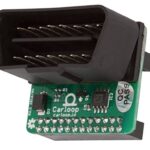The Evaporative Emission Control (EVAP) system in your 2008 Chevy Impala is crucial for preventing harmful fuel vapors from escaping into the atmosphere. A malfunctioning EVAP system can not only contribute to environmental pollution but also trigger the dreaded “Check Engine” light and potentially lead to issues with your vehicle’s performance. Fortunately, with an OBD2 scanner, you can effectively diagnose and pinpoint problems within your Impala’s EVAP system. This guide will walk you through the steps on how to test your 2008 Chevy Impala EVAP system using an OBD2 scanner, ensuring you can maintain your vehicle’s efficiency and stay environmentally responsible.
Understanding the EVAP System and OBD2 Scanners
Before diving into the testing process, it’s important to understand what the EVAP system does and how an OBD2 scanner aids in diagnosing it. The EVAP system captures fuel vapors from the fuel tank and prevents them from being released into the air. It stores these vapors and then purges them into the engine to be burned during normal operation. This system is monitored by your car’s computer, and any leaks or malfunctions can be detected.
An OBD2 (On-Board Diagnostics II) scanner is a tool that connects to your vehicle’s diagnostic port, allowing you to communicate with the car’s computer. It can read diagnostic trouble codes (DTCs), monitor live data, and perform various tests, including EVAP system tests. For DIY enthusiasts and car owners, an OBD2 scanner is an invaluable tool for diagnosing issues and saving on potential repair costs.
Step-by-Step Guide to Testing Your 2008 Chevy Impala EVAP System
Here’s a detailed guide on how to test your 2008 Chevy Impala’s EVAP system using an OBD2 scanner.
1. Gather Your Tools and Prepare Your Vehicle
- OBD2 Scanner: Ensure you have a compatible OBD2 scanner. There are many options available, from basic code readers to more advanced scan tools.
- 2008 Chevy Impala: Make sure your vehicle is safely parked and the engine is off.
- Vehicle’s Repair Manual (Optional): While not essential, your vehicle’s repair manual can provide specific information about your EVAP system and recommended testing procedures.
2. Locate the OBD2 Port
The OBD2 port in a 2008 Chevy Impala is typically located under the dashboard on the driver’s side. It’s usually near the steering column or in the vicinity of the pedals. Refer to your vehicle’s manual if you have trouble locating it.
3. Connect the OBD2 Scanner
With the ignition turned off, plug your OBD2 scanner into the diagnostic port. Ensure it’s firmly connected.
4. Turn the Ignition to the “ON” Position (Engine Off)
Turn your key to the “ON” position. This powers up the car’s electrical system and allows the OBD2 scanner to communicate with the computer, but do not start the engine.
5. Navigate to Diagnostic Menu and Read Diagnostic Trouble Codes (DTCs)
Follow your OBD2 scanner’s instructions to navigate to the diagnostic menu. Select the option to “Read Codes” or “Trouble Codes.” The scanner will retrieve any stored DTCs in the vehicle’s computer.
Pay close attention to codes related to the EVAP system. These codes typically start with “P04” followed by two additional digits. Common EVAP codes include:
- P0440: EVAP Emission Control System Malfunction
- P0442: EVAP Emission Control System Leak Detected (Small Leak)
- P0455: EVAP Emission Control System Leak Detected (Gross Leak)
- P0457: EVAP Emission Control System Leak Detected (Fuel Cap Loose/Off)
Alt text: An OBD2 scanner displaying diagnostic trouble codes on its screen, highlighting the process of reading error codes related to a car’s system.
Record any EVAP-related codes you find. These codes offer a starting point for diagnosing the specific problem within the EVAP system.
6. Check EVAP System Readiness Monitors
OBD2 scanners can also check the status of “Readiness Monitors.” These monitors are self-tests that the vehicle’s computer performs on various systems, including the EVAP system, to ensure they are functioning correctly.
Navigate through your scanner’s menu to find “Readiness Monitors” or “I/M Readiness.” Look for the EVAP monitor status.
- Ready or Complete: Indicates the EVAP system monitor has run and completed its test.
- Not Ready or Incomplete: Indicates the EVAP system monitor has not yet run or has not completed its test. This could be normal if you’ve recently cleared codes or disconnected the battery, as monitors need to run through specific drive cycles to complete. However, if it remains “Not Ready” for an extended period, it could suggest an issue preventing the test from running, or point to a fault.
Alt text: A close-up of an OBD2 scanner screen displaying readiness monitor status, showing “EVAP System Monitor: Ready” indicating the system has passed its self-test.
7. Perform EVAP System Tests (If Scanner Capable)
Some advanced OBD2 scanners offer specific EVAP system tests. These tests can actively command components of the EVAP system to operate and monitor their response. Common tests include:
- EVAP Purge Valve Test: This test commands the purge valve to open and close, allowing you to verify its functionality.
- EVAP Vent Valve Test: This test commands the vent valve to open and close, ensuring it is operating correctly.
Refer to your OBD2 scanner’s manual for instructions on how to perform these active tests. By running these tests, you can isolate whether specific components like valves are functioning as they should.
8. Analyze Live Data (Advanced Diagnosis)
For more in-depth diagnosis, use your OBD2 scanner to monitor live data related to the EVAP system. Key parameters to observe include:
- Fuel Tank Pressure (FTP) Sensor: This sensor measures the pressure or vacuum within the fuel tank. Abnormal readings can indicate leaks or blockages.
- EVAP Purge Valve Duty Cycle: This indicates the percentage of time the purge valve is commanded to be open.
- EVAP Vent Valve Status: Shows whether the vent valve is open or closed.
Alt text: An OBD2 scanner screen showcasing live data stream, displaying real-time sensor readings and parameters related to a vehicle’s engine performance and emissions systems.
By observing these parameters while the engine is running and under different conditions (idle, acceleration, deceleration), you can gain insights into the EVAP system’s behavior and pinpoint irregularities.
9. Interpret Your Findings and Take Action
Based on the DTCs, readiness monitor status, active tests, and live data, you can start to interpret the findings:
- EVAP Codes Present: If you found EVAP-related DTCs, research each code specifically to understand the potential causes. Common issues include leaks in hoses or lines, faulty purge or vent valves, a bad gas cap, or issues with the charcoal canister.
- Readiness Monitor Not Ready: If the EVAP monitor is “Not Ready,” and you haven’t recently cleared codes or disconnected the battery, investigate potential issues preventing the monitor from running. This could be related to a sensor malfunction or a system fault.
- Abnormal Live Data: Unusual readings in FTP sensor, purge valve duty cycle, or vent valve status can indicate specific component failures or system leaks.
Possible Next Steps:
- Visual Inspection: Inspect all EVAP system components you can access, including hoses, lines, valves, and the gas cap, for signs of damage, cracks, or loose connections.
- Smoke Test: For pinpointing leaks, a smoke test is highly effective. This involves introducing smoke into the EVAP system and observing where it escapes to identify leak points. This is often done by professional mechanics.
- Component Replacement: Based on your diagnosis, you may need to replace faulty components like the gas cap, purge valve, vent valve, or hoses.
10. Clear Codes and Re-Test (After Repairs)
After performing any repairs, use your OBD2 scanner to clear the DTCs. Then, drive your 2008 Chevy Impala through a proper drive cycle to allow the EVAP readiness monitor to run and complete. Re-scan to ensure no new codes are set and that the EVAP monitor now shows “Ready.”
Common EVAP System Issues in 2008 Chevy Impala
Several common issues can affect the EVAP system in a 2008 Chevy Impala:
- Loose or Faulty Gas Cap: This is a frequent cause of small EVAP leaks (P0457, P0442). Ensure your gas cap is properly tightened and consider replacing it if it’s old or damaged.
- Purge Valve or Vent Valve Failure: These valves can fail to open or close correctly, leading to various EVAP codes.
- Cracked or Damaged Hoses and Lines: Age and heat can cause EVAP hoses and lines to crack, leading to leaks.
- Charcoal Canister Problems: The charcoal canister can become saturated or damaged, affecting the system’s ability to store and purge vapors.
- Faulty Sensors: While less common, sensors like the FTP sensor can fail, providing incorrect readings and triggering codes.
Conclusion
Testing your 2008 Chevy Impala’s EVAP system with an OBD2 scanner is a straightforward process that can save you time and money by allowing you to diagnose issues accurately. By following this guide, you can effectively read codes, check readiness monitors, perform active tests, and analyze live data to pinpoint EVAP system problems. Remember to consult your vehicle’s repair manual and consider seeking professional help if you are uncomfortable performing these tests or repairs yourself. Maintaining a properly functioning EVAP system is not only essential for your vehicle’s performance but also for environmental responsibility.

